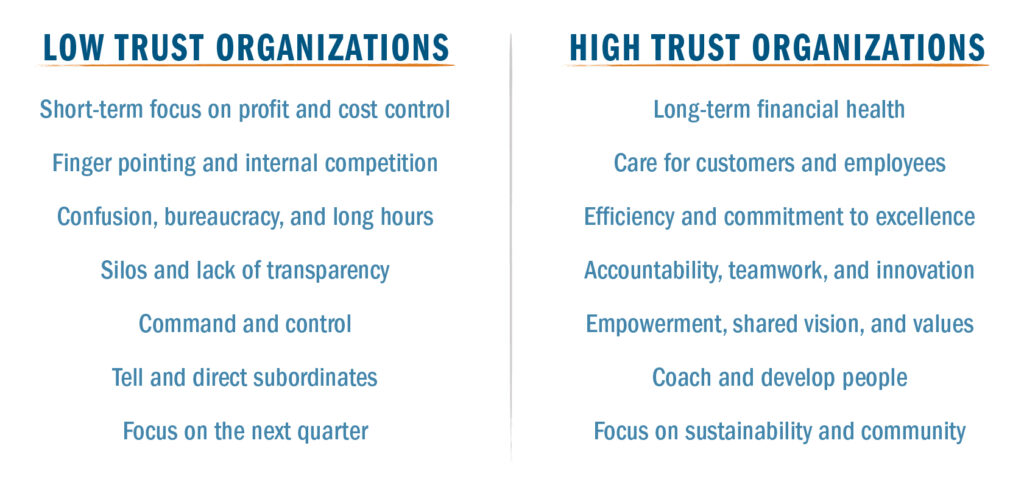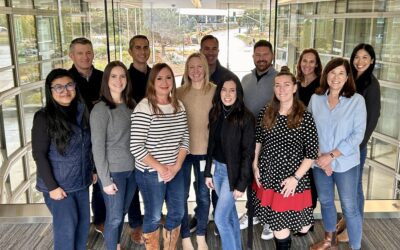Bridging the Gap
All organizations navigate complexity in today’s economic environment due to the shifting priorities of their workforce, customers, and communities. Sometimes this complexity can make us feel overwhelmed or confused. At some organizations, this complexity leads to a more devastating undercurrent: an erosion of trust at all levels, between managers and employees, employees and teams, customers and organizations, or even organizations and communities.
When trust is missing, we can feel resentful and blame the other party. Or maybe we become resigned to our fate, believing nothing we do can make a difference. In short, employee engagement and accountability go out the window, negatively impacting the organizational culture in the process.
Defining the culture gap.
Each organization is unique. And yet, many organizations face culture challenges that are remarkably similar. Often there’s a culture gap between what an organization’s culture really is and what they want it to be. When we assess and measure culture from a developmental perspective, we find patterns of issues causing these culture gaps that vary mostly in severity and degree of dysfunction.
Roughly three of four organizations face some version of the culture gap. And generally, this gap can be traced to a single underlying element: trust. I’ve outlined the characteristics of low-trust organizations vs. high-trust ones. Do any of these common culture gaps sound familiar?
Thankfully, we can rebuild trust and bridge the culture gap between organizations and employees. There are proven methods for building, rebuilding, or maximizing trust that focus on several leadership behaviors to produce the right mindsets for fostering a culture of high trust.
Behaving your way into a new mindset.
Jerry Sternin, father of applied positive deviance, once said, “It’s easier to act your way into a new way of thinking, than think your way into a new way of acting.”
Getting people to make small, incremental changes in behavior is the easiest way to help them make big changes in how they think about their job. For instance, when leaders learn to coach, ask questions, and listen, then they begin to see their job as developing people to solve their own problems. Each time a leader opts to coach rather than tell, another building block of trust is added to bridge the gap. Over time, the bridge is built and the chasm crossed.
Starting at the top.
Change starts at the top, and for two reasons:
First, cultural gaps tend to reflect the shadow of leadership. When leaders are aligned on cultural values, the organization is clear on the path forward and everyone understands the desired behaviors. That means they’re ready to work together to bridge any culture gap they come across. The opposite is also true. Any lack of cohesion among leaders often shows up in the culture (expressed as confusion, blame, lack of transparency, or internal competition).
Second, culture change requires leadership buy-in, both by word and by action. For change to be truly sustainable, all leaders need to recognize the need for change and adopt the new behaviors.
Giving people time to change.
Building trust takes time, meaning that real, sustainable culture change takes time. People also need time to try out new behaviors and build new habits. Teaching new skills and behaviors in small, bite-sized bits gives people that time.
I believe in empowering people to experiment with new approaches to build their new skills and habits over time. It gives them the space to practice, provide feedback, and try new things.
What does empowering people to experiment look like?
- Short, impactful learning sessions focused on a single behavior
- On-the-job assignments to try out the new behavior
- Peer-to-peer practice to build team cohesion, support teammates, and share best practices
- One-on-one coaching from executive leadership coaches
- Job aids to provide on-demand, in-the-moment tips and reminders
- Supervised group coaching to get real-time feedback from a seasoned expert
- Interactive journals to capture reflections and learning
- Online collaboration tools to create virtual “centers of excellence” that support the new coaching and communication skills
Changing conversations to change the culture.
Our daily conversations are the ultimate driver of desired outcomes. So why not change the quality of our conversations in the workplace to build a workplace culture of high trust? We can change our conversations by better understanding and utilizing the three levels of conversation, as developed by Judith Glaser: transactional conversations, positional conversations, and transformational conversations.
In transactional conversations, we exchange information and confirm what we already know. Positional conversations are persuasive conversations that allow us to exchange power or defend what we don’t know. And transformational conversations are co-created, exploratory conversations in which we meaningfully exchange energy and discover new things.
None of these conversation levels are inherently good or bad, but a healthy organization should have a solid mix of all three. It’s probably no surprise that most low-trust organizations tend to only have transactional or positional conversations, whereas high-trust organizations have many more transformational conversations.
High trust leads to high performance.
Look at any high-performance organization, and I guarantee that they are built on a foundation of trust. When we are part of a high-trust organization, we have the tools to address a culture gap, take the time to adapt and experiment, and have healthy, empowering conversations along the way.
Trust is developed one relationship at a time, one conversation at a time. When leaders achieve alignment in goals, buy in to the change, and develop coaching skills to develop their people, they can empower their organizations to achieve long-term, sustainable success in transforming their culture.
Want to learn more about the tools for bridging the culture gap? Let’s talk! Give us a call at (859) 415-1000 or drop us a line in the form at the bottom of this page.





